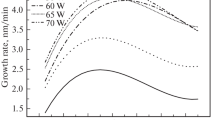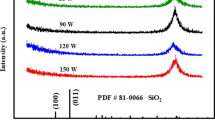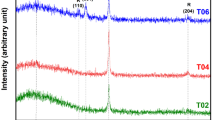Abstract
Advantages of fabricating precision optical coatings by magnetron sputtering with a gas discharge powered from a medium-frequency current-variation supply unit are considered. The significance of selecting optimal characteristics and operating modes of the power supply sources of the magnetron sputtering system (MSS) for fabrication of high-quality optical coatings is justified. Using the developed magnetron sputtering facility that comprises a multimode power supply unit of the MSS, samples with thin TiO2 films were fabricated at different recurrence frequencies fmag of the current pulses transmitted to the MSS and under other identical sputtering conditions. The samples were tested by laser ellipsometry, atomic force microscopy, X-ray diffractometry, and X-ray reflectometry. The influence of fmag on the functional properties of the TiO2 films, namely, the refractive index, density, and roughness, is shown.






Similar content being viewed by others
REFERENCES
Kuz’michev, A.I., Magnetronnye raspylitel’nye sistemy. Kniga 1. Vvedenie v fiziku i tekhniku magnetronnogo raspyleniya (Magnetron Sputtering Systems, Book 1: Introduction to the Physics and Technology of Magnetron Sputtering), Kiev: Avers, 2008.
Vol’pyan, O.D., Kuz’michev, A.I., Obod, Yu.A., and Yakovlev, P.P., Production of optical nanogradient and meta-coatings by magnetron sputtering, Nanoinzheneriya, 2011, no. 4, pp. 37–39.
Abramov, N.F., Volpyan, O.D., Obod, Yu.A., and Dronskii, R.V., Fabrication of nanogradient coatings for laser devices using the method of magnetron sputtering, Quantum Electron., 2013, vol. 43, no. 9, pp. 791–794.
Gueldner, H., Wolf, H., Eckholz, F., and Schrade, F., A novel topology for pulse generators in magnetron sputter systems, Proc. VII IEEE International Power Electronics Congr., Acapulco, Mexico, 2000, pp. 365–370.
Sidoryuk, O.E. and Skvortsov, L.A., Measurement of absorption by means of laser intracavity photothermal radiometry, J. Appl. Spectrosc., 1992, vol. 56, nos. 5–6, pp. 473–477.
Astapenko, V.A. and Sidoryuk, O.E., Detection of laser damage to the surfaces of materials and coatings with the aid of an induced gas discharge, Quantum Electron., 1997, vol. 27, no. 7, pp. 592–595.
Vol’pyan, O.D., Yakovlev, P.P., Meshkov, B.B., and Obod, Yu.A., Obtaining TiO2 optical films by reactive ac magnetron sputtering, J. Opt. Technol., 2001, vol. 68, no. 7, pp. 484–487.
Brodie, I. and Murray, J., Physics of Microfabrication, New York: Plenum, 1982.
Kaiser, N., Review on fundamentals of thin-film growth, Appl. Opt., 2002, vol. 41, no. 16, pp. 3053–3060.
Jonsson, L.B. et al., Frequency response in pulsed DC reactive sputtering processes, Thin Solid Films, 2000, vol. 365, no. 1, pp. 43–48.
Bradley, J.W. et al., The distribution of ion energies at the substrate in an asymmetric bi-polar pulsed DC magnetron discharge, Plasma Sources Sci. Technol., 2002, vol. 11, no. 2, pp. 165–174.
Franz, R. et al., Observation of multiple charge states and high ion energies in high-power impulse magnetron sputtering (HiPIMS) and burst HiPIMS using a LaB6 target, Plasma Sources Sci. Technol., 2014, vol. 23, pp. 0350011–03500111.
Yukimura, K. et al., High-power inductively coupled impulse sputtering glow plasma IEEE, Trans. Plasma Sci., 2011, vol. 39, no. 11, pp. 3085–3094.
ACKNOWLEDGMENTS
This work was supported by the Ministry of Science and Education of the Russian Federation, project “Optical Metamaterial-Based Transistors,” agreement no. 14.577.21.0219 dated September 29, 2016, on provision of grant, unique Applied Research and Experimental Development identifier RFMEF157716X0219. We are grateful to K.D. Shcherbachev, D.A. Kiselev, and R.N. Zhukov, employees of National University of Science and Technology MISiS, for their assistance with conducting experiments.
Author information
Authors and Affiliations
Corresponding author
Additional information
Translated by O. Lotova
Rights and permissions
About this article
Cite this article
Abramov, N.F., Bezrukov, A.V., Vol’pyan, O.D. et al. The Influence of the Power Supply of a Magnetron Sputtering System on the Properties of the Deposited TiO2 Films. Inorg Mater 54, 1491–1497 (2018). https://doi.org/10.1134/S0020168518150025
Received:
Published:
Issue Date:
DOI: https://doi.org/10.1134/S0020168518150025




